White Miso Made Easy: Danno Mariko’s Quick Recipe
Sep 14,2023
White Miso Made Easy: Danno Mariko’s Quick Recipe
Sep 14,2023
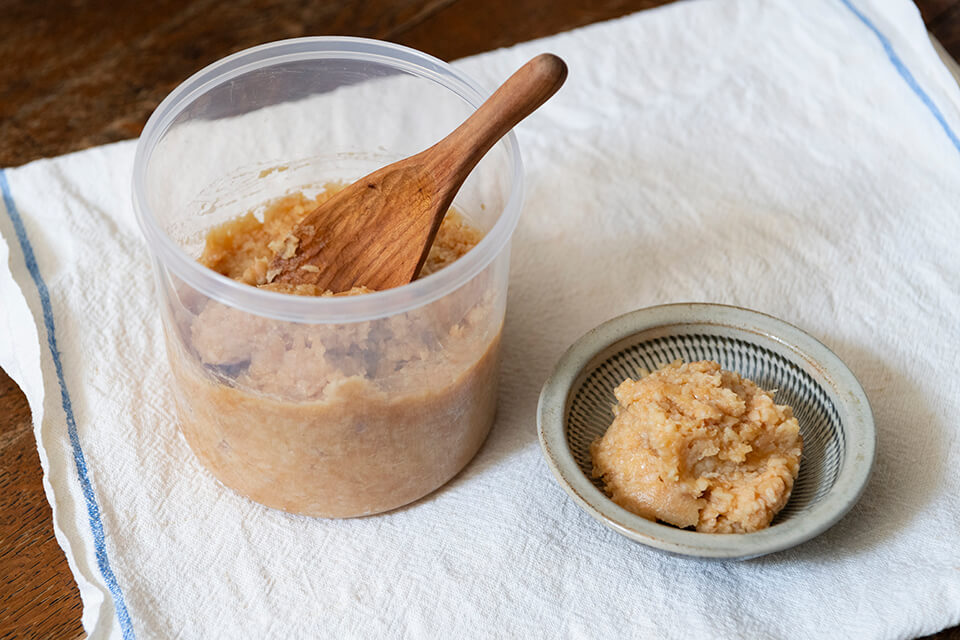

Miso comes into its own during fall and winter. When making regular miso at home, you have to prepare the paste during the cold months, then let it age for six months to a year. But the white miso featured here can be made whenever you like and is ready literally overnight.
Food stylist Danno Mariko has dedicated her life to making fermented and other preserved foods. She’s even written books about them. For this installment, she demonstrated how to make white miso and shared some serving suggestions. She also showed us some of her unusual handcrafted fermented foods.
When devising a preserved food recipe, Mariko enjoys giving her own unique twist to a time-honored technique or the production process followed by some storied food establishment. “When I developed this white miso recipe, too, I referred to some of the steps in how miso is made at a miso factory.”
White miso is made with 2.5 times the usual amount of rice koji.
“It contains tons of koji, so it’s celebrated for its beauty benefits. It doesn’t have much salt, it tastes mildly sweet, plus it’s got plenty of umami to boot. I keep a pickling bed made by mixing two parts white miso with one part sake lees, and when I pickle leftover vegetables or fillets of fish in it, it’s amazing how good they taste.”
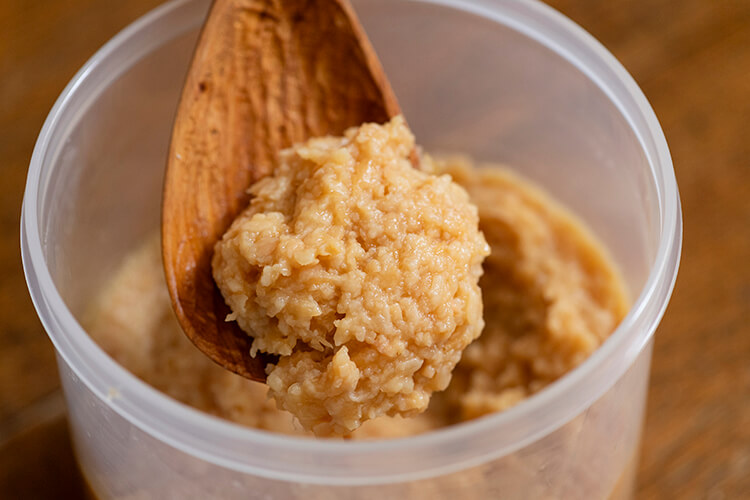
Freshly made white miso. It contains lots of koji grains, as you can tell just by looking.
It takes two to four weeks to ferment white miso at room temperature. Here Mariko explains how to do so using the “Keep Warm” setting of your rice cooker instead. “Maintaining a constant temperature of around 60 degrees Celsius turbocharges the fermentation process. The miso is ready in about 17 hours in summer and 22 hours in winter.”
It’s important, however, to ensure that the temperature doesn’t rise too high, Mariko cautions. “If the temperature gets too hot, it will kill the koji mold and stop the fermentation process in its tracks. So you need to exercise caution. The trick is to leave the lid of the rice cooker open and place a tea cloth at the bottom so the inner pot doesn’t come into direct contact with the heating element underneath. The mixture will heat uniformly as long as you spread the starter miso as evenly as possible in the container, without leaving any space.”
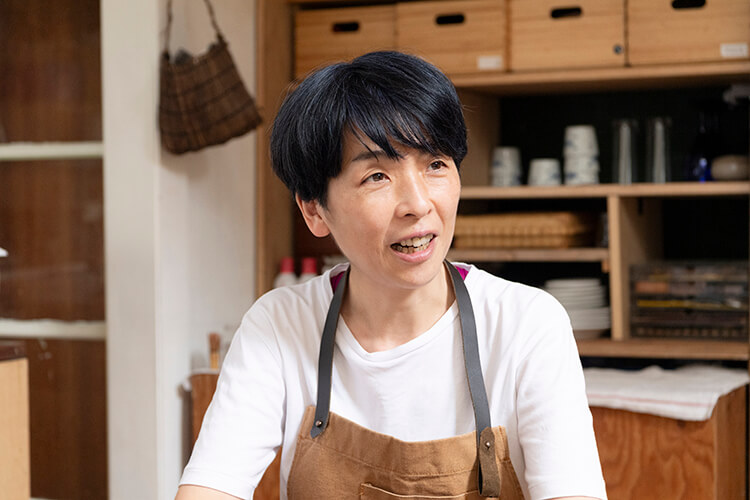
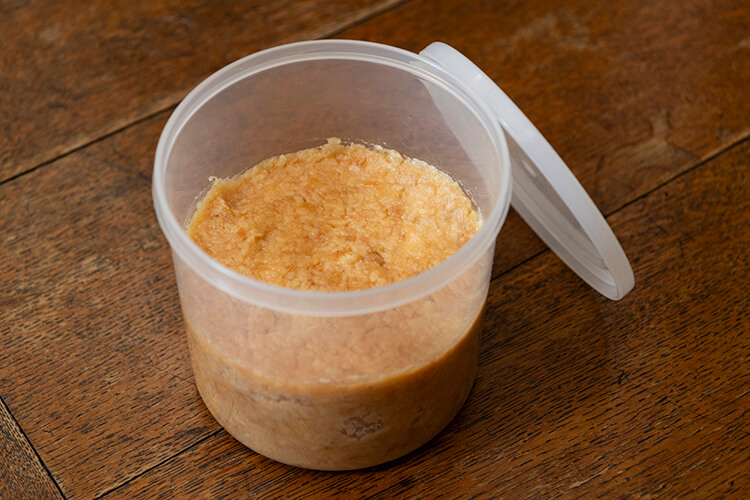
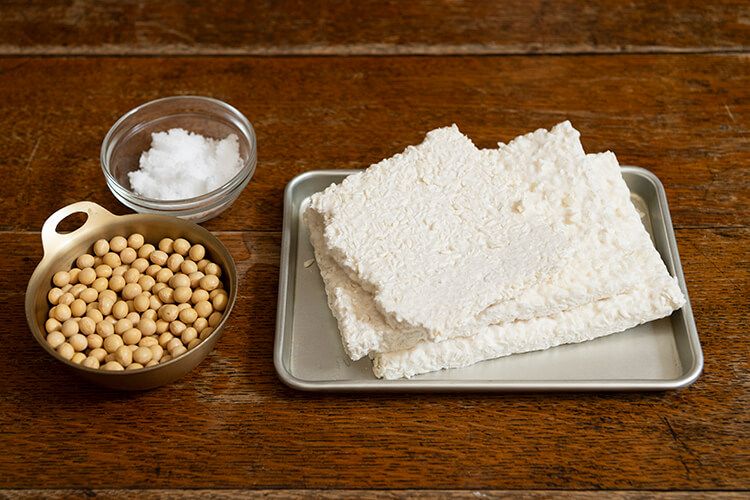
The koji can be either fresh or dried, but “I use the fresh kind,” says Mariko, “because I feel it’s a more powerful fermenter. The koji mold is still alive and kicking.”
2.Once the soybeans absorb enough water, place the pan over medium heat. Once it comes to the boil, skim off the scum (the darkish film that forms initially; the white scum that appears later doesn’t need to be removed). Place the lid on and turn the heat to low. Boil the soybeans until they’re soft enough to crush, taking care that the water doesn’t boil over.
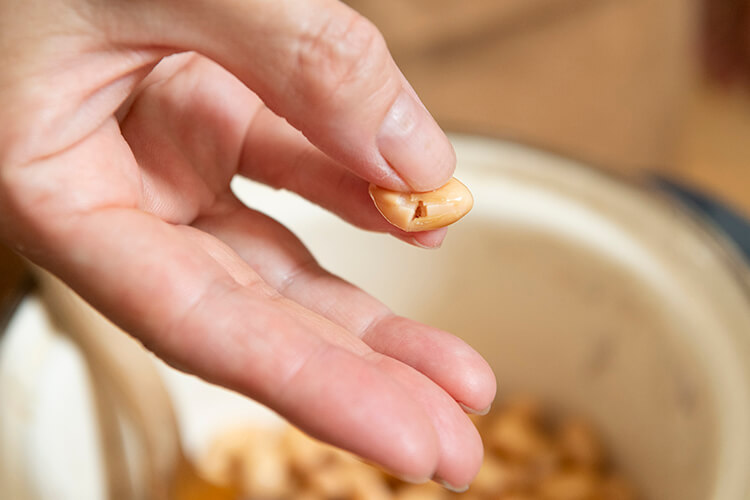
The soybeans should be boiled enough that they can easily be crushed between the thumb and little finger.
Suggested boiling times are 2-3 hours in a regular pan, 1½-2+ hours in an enameled cast iron pan, and 20 minutes in a pressure cooker.
4.Put the soybeans in a thick plastic bag. Crush into a smooth paste with the base of the thumb. Let cool off slightly.
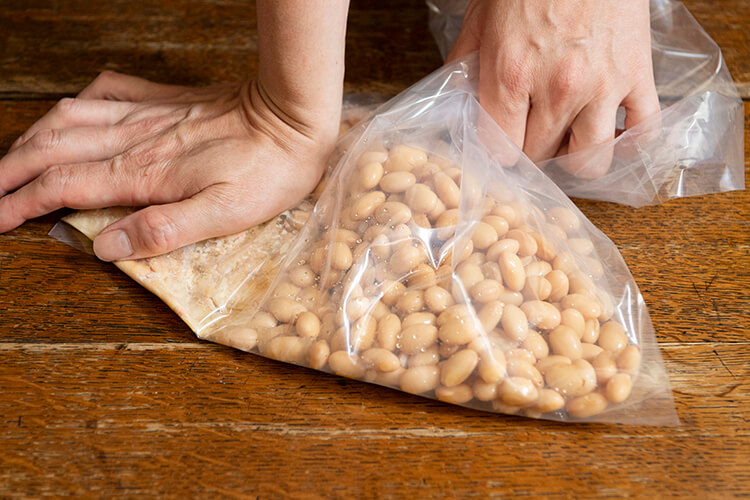
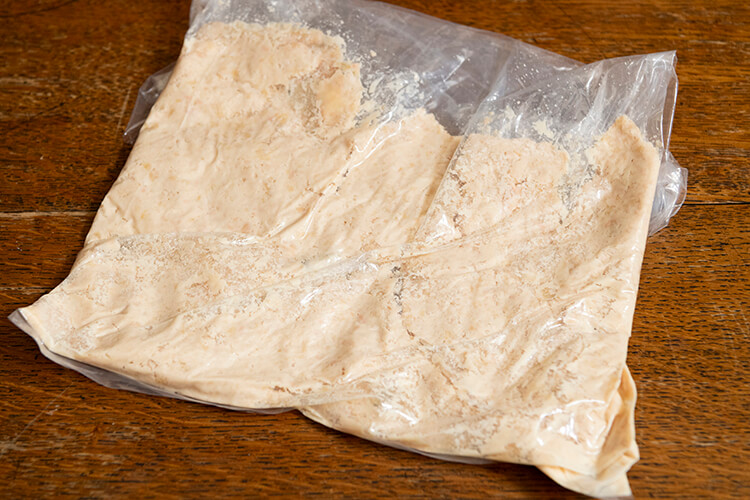
With the base of your thumb, crush the soybeans through the bag while holding the mouth closed with your other hand (left).
If the beans are still hard, you won’t be able to crush them. They’ll just slip away from under your hand. It doesn’t matter if they retain something of their shape (right).
5.Place the koji in a separate thick plastic bag and knead through the bag. Add the salt and mix in.
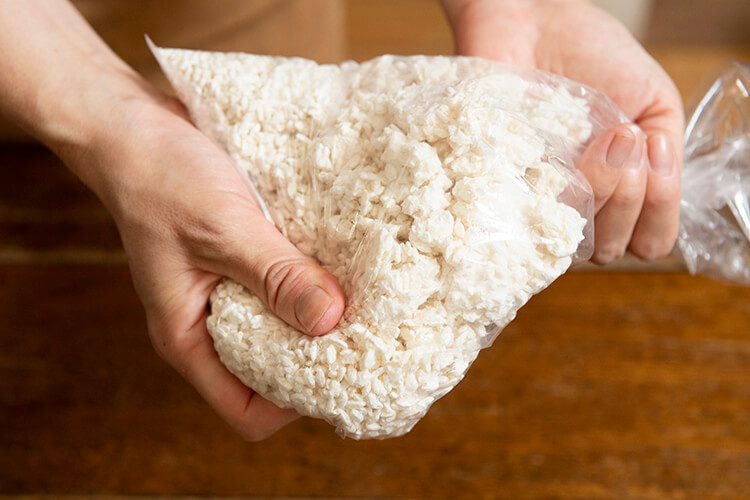
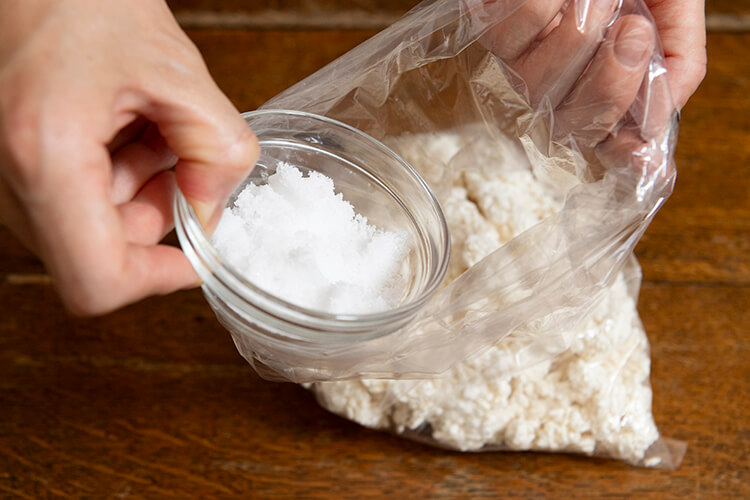
Mixing the koji and salt together first ensures they blend evenly into the soybeans.
6.Add the koji from Step 5 to the soybeans from Step 4. While shaking the bag, mix them together well until the entire mixture is uniform.
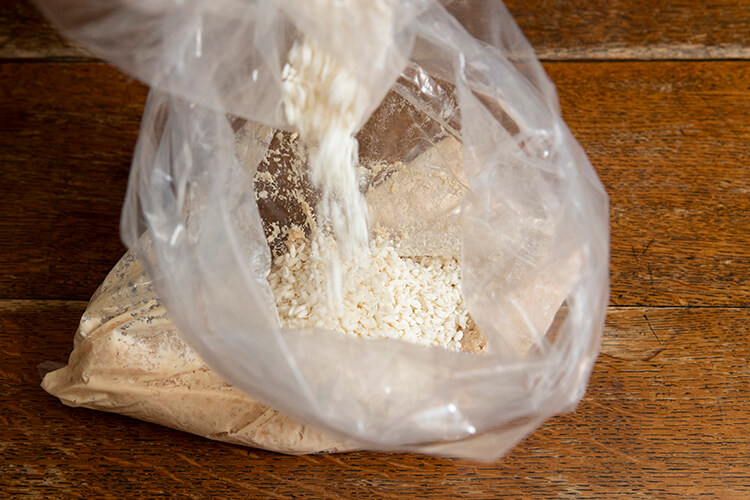
To avoid killing the koji mold, mix it in after letting the soybeans cool to under 60˚C.
7.Add approx. 100ml of the liquid saved from Step 3 and mix in while keeping an eye on how the mixture is coming along. Form into a ball with your hands, adjusting so that the surface is moist but not wet.
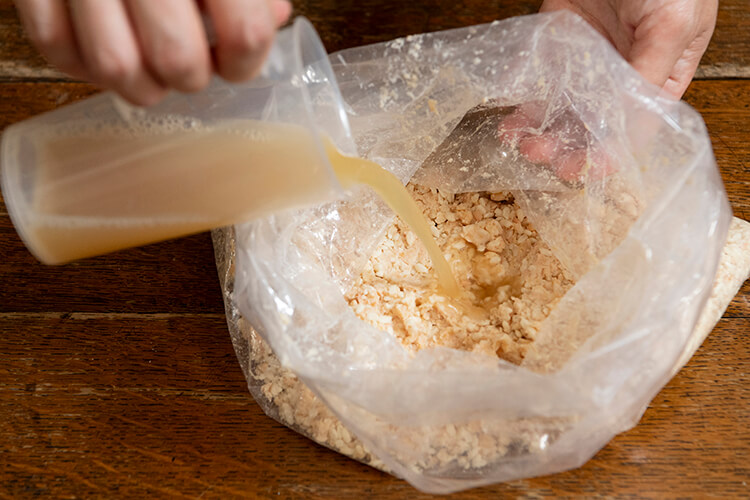
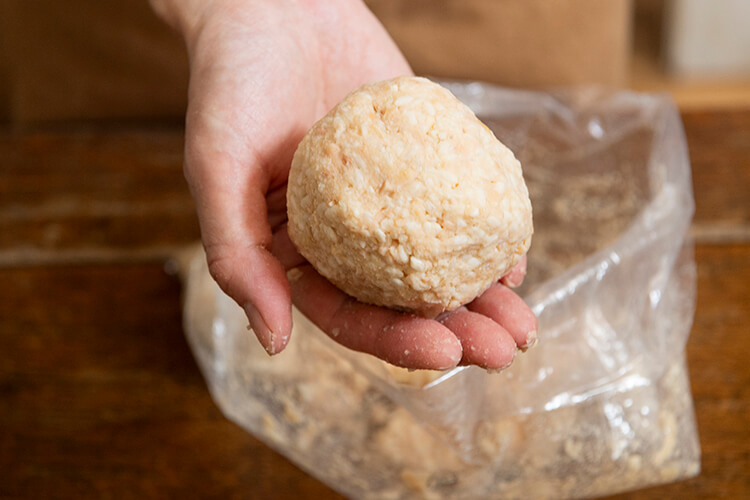
The koji tends to absorb moisture after the liquid is added. The trick is to mix it in quickly.
8.Place the mixture from Step 7 in a heat-resistant container, pressing it down with your fist. Don’t leave any empty space at the bottom or sides. Cover the mouth of the container tightly with aluminum foil. Pierce it with chopsticks in several places.
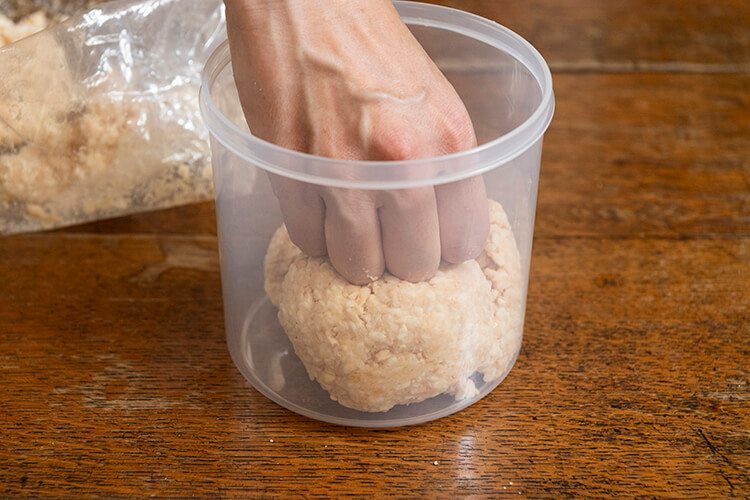
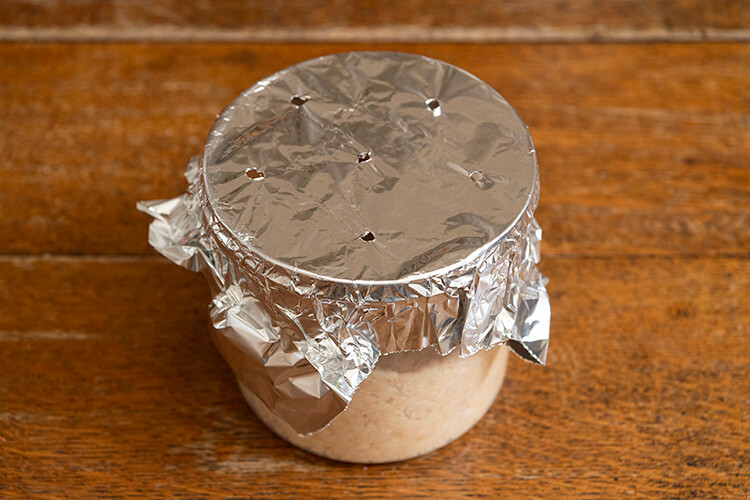
Not leaving any empty space ensures that the mixture heats evenly (left).
The holes in the aluminum-foil cover are designed to let air escape (right).
9.Place a folded tea cloth at the bottom of the inner pot of the rice cooker. Put the container from Step 8 on top of it. Pour in lukewarm water (approx. 40℃) until level with the top of the mixture in the container. Leave the lid of the rice cooker open and place a tea cloth over it.

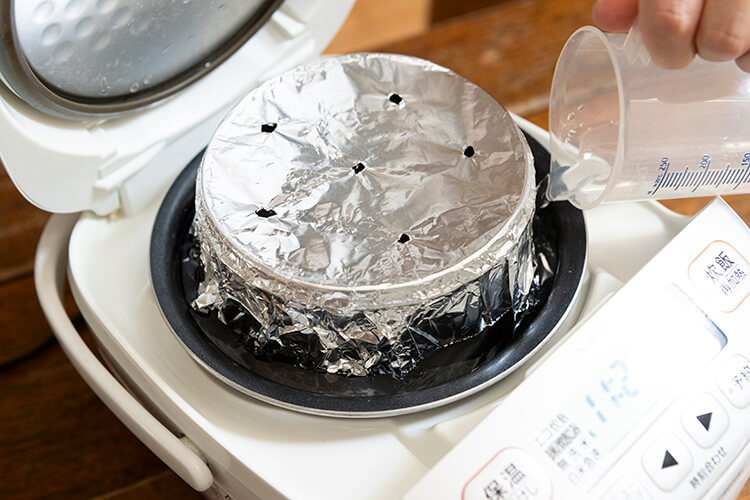

Place a tea cloth at the bottom of the inner pot to prevent the temperature from rising too high and the contents from evaporating (upper left).
After adding lukewarm water (upper right), set to “Keep Warm” with the lid of the rice cooker completely open (below).
10.If the water level decreases, top up with cold water. Set the rice cooker to “Keep Warm.” Leave for an average of 17 hours in midsummer and 22 hours in midwinter. Partway through, remove once and mix so that the miso ferments uniformly. When the koji grains turn soft, remove from the inner pot. Strain to taste.
NOTE: Place the miso in a storage container so it doesn’t dry out. It will keep for a week in the fridge and six months in the freezer.
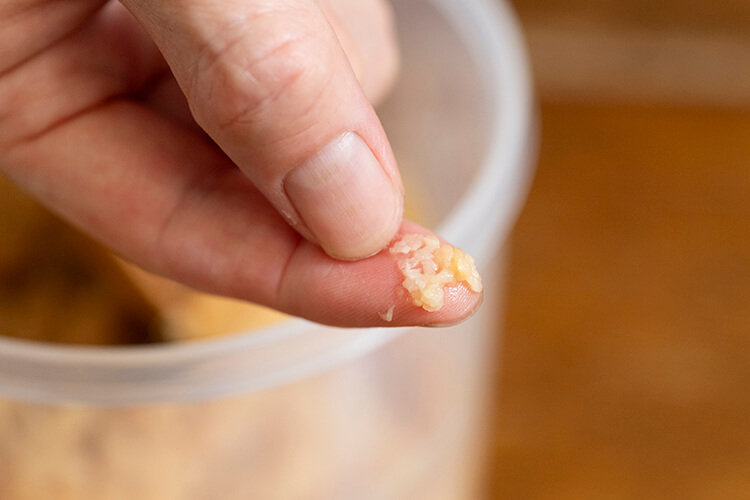
The miso is ready when the koji can be lightly crushed between the fingers. If you heat it for too long, it will take on a sour taste and turn the color of red miso. Keep an eye on it until it’s just right.
Not only can this white miso be used to make a pickling bed. Mariko also shared her own ways of enjoying it.
“It makes a delicious vegetable dip as is, but I’d recommend using it to flavor shiraae (mashed tofu salad). Place 50 grams of silken tofu, a tablespoon of white miso, and half a tablespoon of white sesame in a plastic bag. Then mash the tofu and mix. And that’s it. With its sweet flavor and moderate saltiness, white miso is all that’s required to define the taste. No need to add multiple flavorings like soy sauce or mirin (sweetened sake) or sugar. You can adjust the flavor with a little salt if you like.”
White miso goes wonderfully with eggplant as well. “Dilute white miso with a little sake, glaze some eggplant with it, then grill it on a skewer to make eggplant dengaku. Deep-fried eggplant also tastes delicious basted in white miso.”
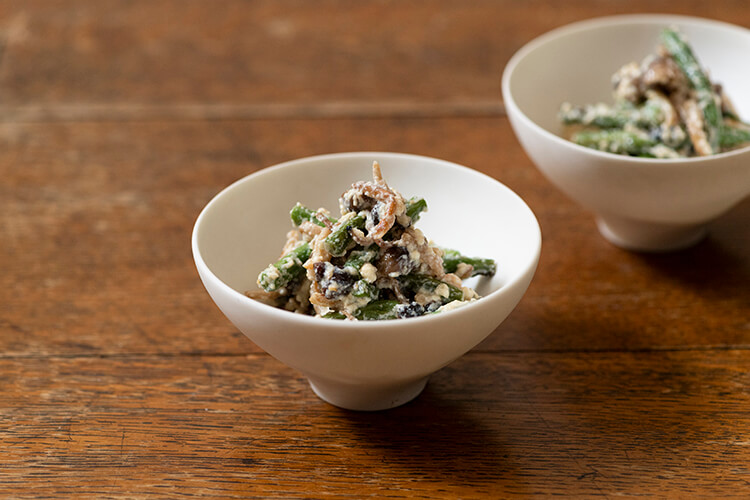
Shimeji mushrooms and green beans dressed in white miso. Slowly cooking the ingredients in sesame oil before mixing in the dressing concentrates the umami flavor, enhancing the taste.
Mariko started making her own preserved foods after she had her first boy, who is now in high school. “When I became a parent, I found myself with leisure time on my hands. So I started making miso, which I thought would be fun to do with my little one. And that’s how it all began.”
Then she tried her hand at making fermented foods using seasonal ingredients. “The fun thing about making fermented foods is the process of nurturing them. It’s fascinating to watch, say, how salted fish ages. I often eat Japanese pickles. Well, homemade pickles are better-fermented and better-tasting than the store-bought variety. Plus you get to select the ingredients yourself, which is nice.”
Finally, Mariko showed us her own original fermented food creations made by giving her own twist to your standard shoyu koji—koji mixed with soy sauce.
“One thing I always make when mizansho (unripe Japanese pepper) comes into season is shoyu koji with Japanese pepper. All you do is combine unripe Japanese pepper boiled in water with shoyu koji and mix them in the blender. It tastes great on salad or chilled tofu. Then there’s shoyu koji with soybeans. This is made by adding boiled soybeans when making shoyu koji and fermenting them together. It can be used for stewed dishes or soboro (seasoned minced meat). It’s nice and filling because you get to eat the soybeans and all.”
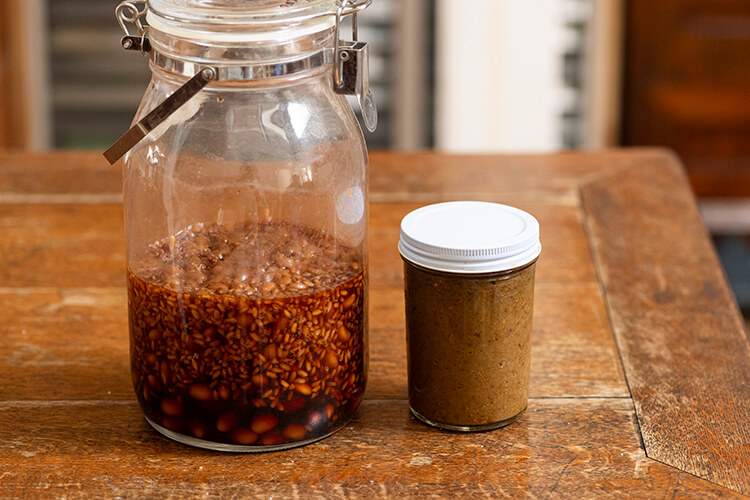
Right: Shoyu koji with Japanese pepper. Left: Shoyu koji with soybeans.
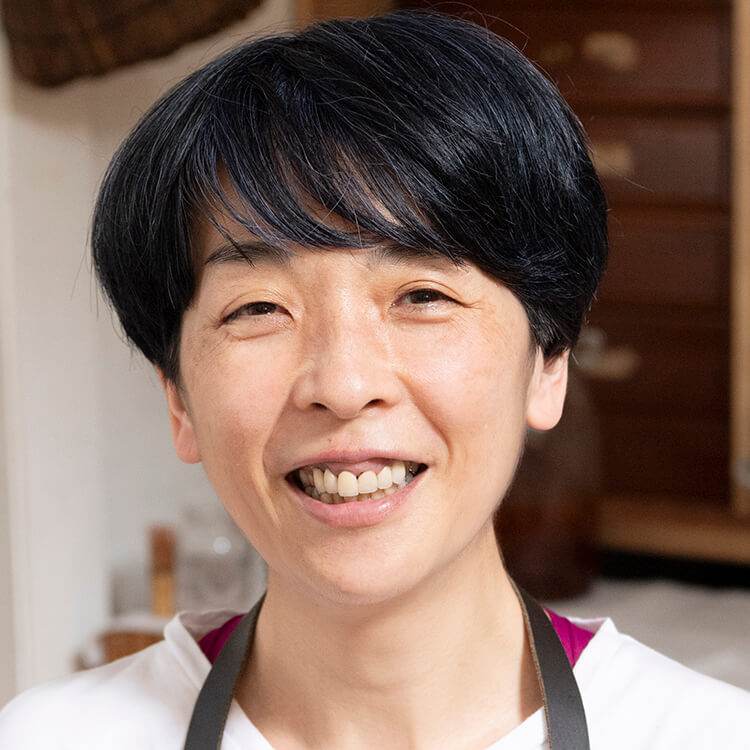
Food stylist and dietitian
Food stylist and dietitian
Danno Mariko runs Minato Gohan, which showcases fresh seafood and other ingredients from Toyosu Fish Market and direct from the port. Her recipes for preserved foods and many other dishes are featured in magazines and books. She also styles food. Among other books, she is the author of Port Town Fishermen’s Meals—Made with Supermarket Fish! (published by Shunyodo Shoten) and Preserved Foods & Serving Techniques (published by Asahi Shimbun Publications).
https://www.instagram.com/marikodanno/